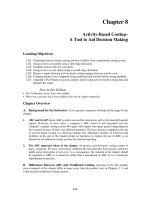Accounting 21th waren reeve fess chapter 08
Bạn đang xem bản rút gọn của tài liệu. Xem và tải ngay bản đầy đủ của tài liệu tại đây (1.69 MB, 46 trang )
Chapter 8
Receivables
Accounting, 21st Edition
Warren Reeve Fess
PowerPoint Presentation by Douglas Cloud
Professor Emeritus of Accounting
Pepperdine University
© Copyright 2004 South-Western, a division
of Thomson Learning. All rights reserved.
Task Force Image Gallery clip art included in this
electronic presentation is used with the permission of
NVTech Inc.
Some
Some of
of the
the action
action has
has been
been automated,
automated, so
so
click
click the
the mouse
mouse when
when you
you see
see this
this
lightning
lightningbolt
bolt in
in the
the lower
lower right-hand
right-hand
corner
corner of
of the
the screen.
screen. You
You can
can point
point and
and
click
click anywhere
anywhere on
on the
the screen.
screen.
Objectives
Objectives
1. List the common classifications of receivables.
2. Summarize and
examples
After
studying
this
Afterprovide
studying
this of internal
control procedures
that
apply
to receivables.
chapter,
you
should
chapter, you should
3. Describe the nature of and the accounting for
be
able
to:
be
able
uncollectible receivables.to:
4. Journalize the entries for the allowance
method of accounting for uncollectibles, and
estimate uncollectible receivables based on
sales and on an analysis of receivables.
Objectives
Objectives
5. Journalize the entries for the direct write-off
of uncollectible receivables.
6. Describe the nature and characteristics of
promissory notes.
7. Journalize the entries for notes receivable
transactions.
8. Prepare the Current Assets presentation of
receivables on the balance sheet.
9. Compute and interpret the accounts
receivable turnover and the number of days’
sales in receivables.
Classification of Receivables
Accounts Receivable—used for selling
merchandise or services on credit, and normally
expected to be collected in a relatively short
period.
Notes Receivable—used to grant credit on the
basis of a formal instrument of credit, called a
promissory note.
Other Receivables—include interest receivable,
taxes receivable, and receivables from officers
and employees.
Separating
Separating the
the Receivable
Receivable Functions
Functions
Credit
Approval
Credit
Info.
Collections
Goods or
services
Sales
Acctg.
Info.
Invoice
Accounting
Acctg.
Info
Uncollectible
Uncollectible Receivables
Receivables
Companies
Companies often
often sell
sell
their
their receivables
receivables to
to other
other
companies.
companies. This
This
transaction
transaction isis called
called
factoring
factoring the
the
receivables,
receivables, and
and the
the
buyer
buyer of
of the
the receivables
receivables
isis called
called aa factor.
factor.
Uncollectible
Uncollectible Receivables
Receivables
The
The Allowance
Allowance Method
Method
This method is consistent with the matching principle.
Management makes an estimate each year of the
portion of accounts receivable that may not be
collectible.
Uncollectible Accounts Expense is debited and
Allowance for Doubtful Accounts is credited.
Actual accounts that prove to be uncollectible are
debited to Allowance for Doubtful Accounts and
credited to Accounts Receivable.
The
The Allowance
Allowance Method
Method
On
On December
December 31,
31, Cynthia
Cynthia Richards
Richards estimates
estimates
that
that aa total
total of
of $4,000
$4,000 of
of the
the $105,000
$105,000 balance
balance in
in
her
her company’s
company’s Accounts
Accounts Receivable
Receivable will
will
eventually
eventually be
be uncollectible.
uncollectible.
Adjusting Entry
Dec. 31 Uncollectible Accounts Expense
Allowance for Doubtful Accounts
4 000 00
4 000 00
The
The Allowance
Allowance Method
Method
The
The net
net amount
amount that
that isis
expected
expected to
to be
be collected,
collected,
$101,000
$101,000 ($105,000
($105,000 ––
$4,000),
$4,000), isis called
called the
the net
net
realizable
realizable value
value (NRV).
(NRV).
The
The adjusting
adjusting entry
entry
reduces
reduces receivables
receivables to
to
the
the NRV
NRV and
and matches
matches
uncollectible
uncollectible expenses
expenses
with
with revenues.
revenues.
The
The Allowance
Allowance Method
Method
The
The
adjusting
adjusting
entry
entry fills
fills
the
the bucket.
bucket.
Adjusting
Entry
Allowance
for
Doubtful
Accounts
The
The Allowance
Allowance Method
Method
e
nc
wa
L
lo r
Al fo TFU s
t
UB un
DO co
ac
Writing
Writing off
off
accounts
accounts
empties
empties the
the
bucket.
bucket.
The
The Allowance
Allowance Method
Method
Jan. 21 Allowance for Doubtful Accounts
Accounts Receivable—John Parker
To write off the uncollectible
account.
On
On January
January 21,
21, John
John
Parker’s
Parker’s account
account totaling
totaling
$610
$610 isis considered
considered to
to be
be
uncollectible.
uncollectible.
610 00
610 00
The
The Allowance
Allowance Method
Method
Jun. 10 Accounts Receivable—John Parker
Allowance for Doubtful Accounts
To reinstate the account
written off on Jan. 21.
An
made
to
On
June
10,
the
An
entry
is
made
to reinstate
reinstate
Onentry
Juneis
10,
the written-off
written-off
John
Parker’s
account.
account
isis collected.
John
Parker’s
account.
account
collected.
610 00
610 00
The
The Allowance
Allowance Method
Method
Jun. 10 Cash
610 00
Accounts Receivable—John Parker
To record collection on
account.
A
A second
second entry
entry isis made
made to
to
record
record receipt
receipt of
of the
the cash.
cash.
610 00
The
The Allowance
Allowance Method
Method
Estimating
Estimating Uncollectible
Uncollectible Accounts
Accounts Expense
Expense
The allowance method uses two ways to
estimate the amount debited to Uncollectible
Accounts Expense.
1. Estimate based on a percentage of sales.
If credit sales for the period are $300,000 and
it is estimated that 1% will be uncollectible,
the Uncollectible Accounts Expense is $3,000.
The
The Allowance
Allowance Method
Method
Adjusting Entry
Dec. 31 Uncollectible Accounts Expense
3 000 00
Allowance for Doubtful Accounts
Based
Based on
on aa Percentage
Percentage of
of Sales
Sales
3 000 00
The
The Allowance
Allowance Method
Method
Estimating
Estimating Uncollectible
Uncollectible Accounts
Accounts Expense
Expense
The allowance method uses two ways to
estimate the amount debited to Uncollectible
Accounts Expense.
2. Estimate based on analysis of receivables.
If it is estimated that $3,390 of the receivables will be
uncollectible and the Allowance for Uncollectible
Accounts currently has a balance of $510, the
Uncollectible Accounts Expense must be debited for
$2,880 ($3,390 – $510).
The
The Allowance
Allowance Method
Method
Adjusting Entry
Dec. 31 Uncollectible Accounts Expense
Allowance for Doubtful Accounts
2 880 00
2 880 00
Based
Based on
on an
an Analysis
Analysis of
of Receivables
Receivables
Accounts Receivable Aging and Uncollectibles
Customer
Balance
Ashby & Co.
B. T. Barr
Brock Co.
$ 150
610
470
Saxon Woods
160
Total
$86,300
Not
Past
Due
Days Past Due
1-30
31-60
61-90 91-180 181-365
over
365
$ 150
$ 350
$260
$ 470
160
$75,000 $4,000
$3,100 $1,900 $1,200
Total
Total accounts
accounts receivable
receivable
shown
shown by
by age.
age.
$800
$300
Accounts Receivable Aging and Uncollectibles
Customer
Balance
Ashby & Co.
B. T. Barr
Brock Co.
$ 150
610
470
Saxon Woods
160
Total
$86,300
Not
Past
Due
Days Past Due
1-30
31-60
61-90 91-180 181-365
over
365
$ 150
$ 350
$260
$ 470
160
$75,000 $4,000
$3,100 $1,900 $1,200
$800
$300
10%
50%
80%
Uncollectibles
PERCENT
2%
5%
20%
30%
Uncollectible percentages based on
experience and industry averages.
Accounts Receivable Aging and Uncollectibles
Customer
Balance
Ashby & Co.
B. T. Barr
Brock Co.
$ 150
610
470
Saxon Woods
160
Total
$86,300
Not
Past
Due
Days Past Due
1-30
31-60
61-90 91-180 181-365
over
365
$ 150
$ 350
$260
$ 470
160
$75,000 $4,000
$3,100 $1,900 $1,200
$800
$300
5%
10%
50%
80%
$200
$310
Uncollectibles
PERCENT
2%
AMOUNT $3,390 = $1,500
20%
$380
30%
$360
$400
$240
Year-End
Year-End Adjustment
Adjustment for
for Uncollectibles
Uncollectibles
General Ledger
Accounts Receivable
A 86,300
Allowance for Doubtful Accts.
510 A
2,880 B
3,390 C
Uncollectible Accts. Expense
B
2,880
Balance Sheet
Accounts receivable
Less allowance for
doubtful accounts
$86,300
Net realizable value
$82,910
A
3,390 C
Balances before adjustment
B Year-end adjustment:
$3,390 – $510 = $2,880
C
Balance after adjustment
Accounting for Uncollectible Accounts Receivable
The Direct Write-Off Method
This method is not consistent with the matching
principle.
Accounts that prove to be uncollectible are written off in
the year they become worthless.
Uncollectible Accounts Expense is debited and
Accounts Receivable is credited for each such
transaction.
The
The Direct
Direct Write-Off
Write-Off Method
Method
May 10 Uncollectible Accounts Expense
420 00
Accounts Receivable—D. L. Ross
To write off an uncollectible
account.
On
On May
May 10,
10, D.
D. L.
L. Ross’
Ross’ account
account was
was
determined
determined to
to be
be uncollectible.
uncollectible. The
The
$420
$420 balance
balance isis written
written off
off the
the books.
books.
420 00









